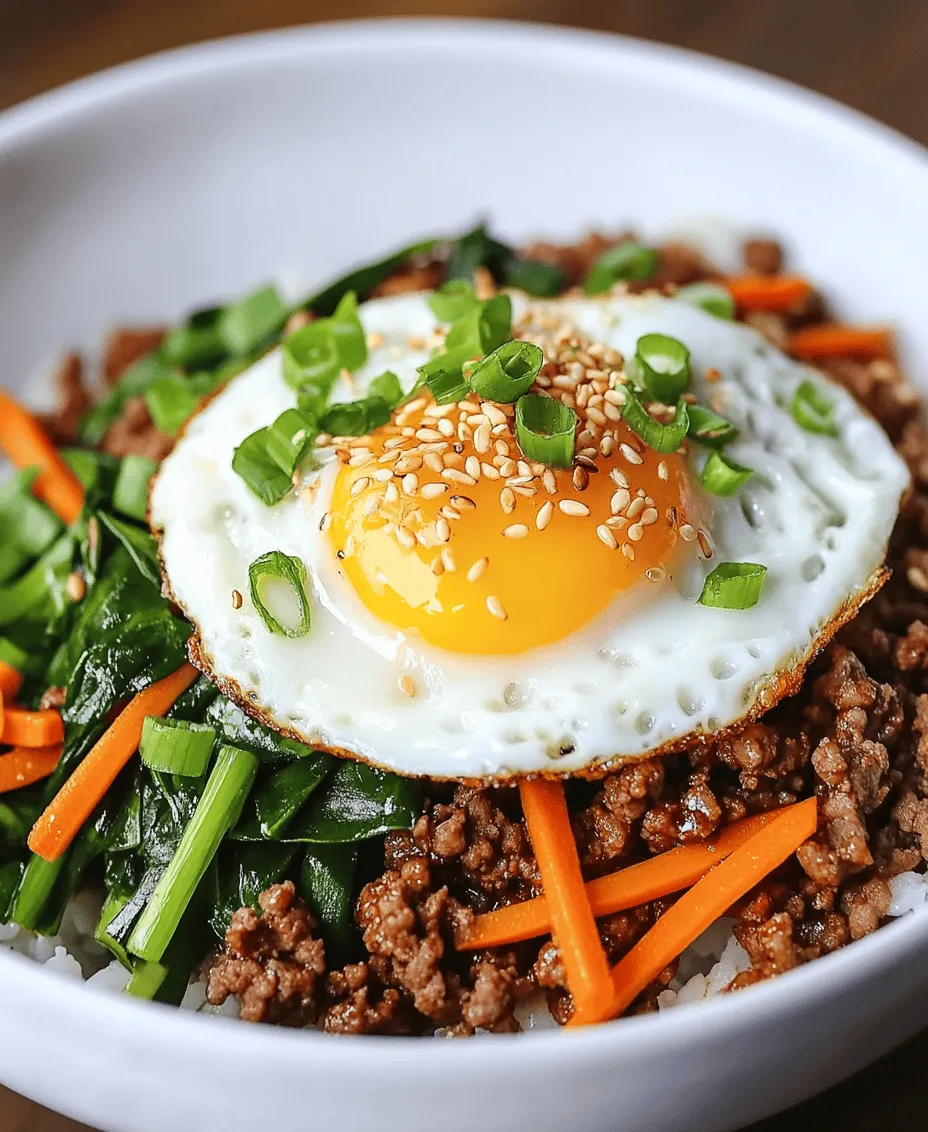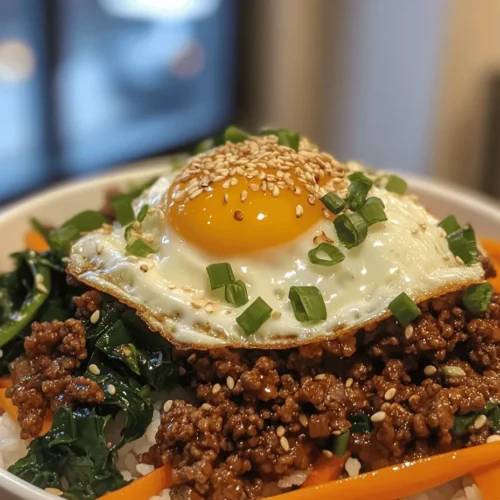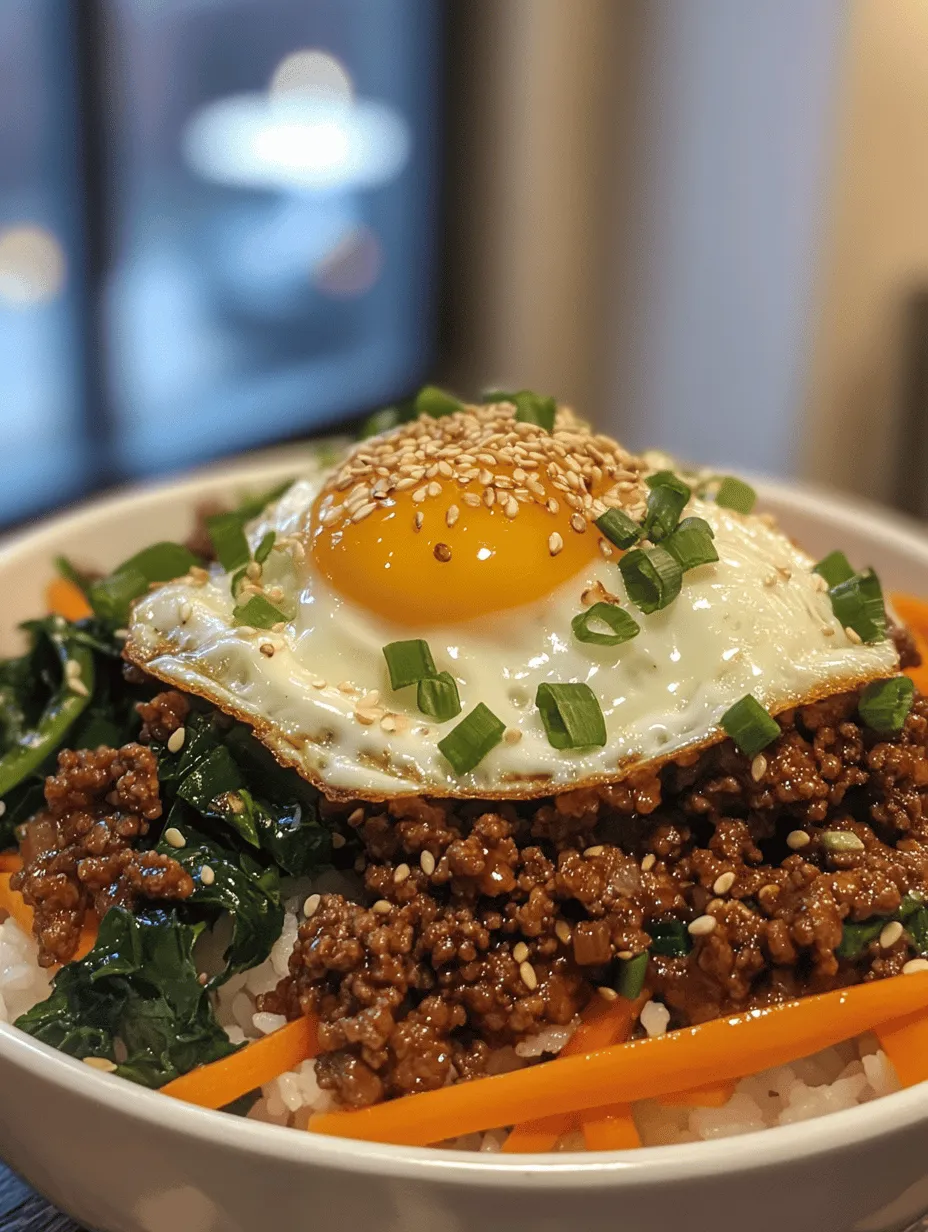In the world of quick and flavorful meals, the Savory Korean Ground Beef Bowl stands out as a delightful fusion of taste and convenience. This dish not only brings the rich flavors of Korean cuisine to your kitchen but also offers a wholesome and satisfying meal perfect for any day of the week. Imagine a steaming bowl of fluffy jasmine rice topped with a generous helping of savory ground beef, colorful vegetables, and a sauce that packs a flavorful punch. With its combination of savory ground beef, aromatic spices, and fresh vegetables, this recipe is sure to become a family favorite.
The Savory Korean Ground Beef Bowl is not just a meal; it’s a culinary experience that showcases the beauty of Korean flavors. The balance of sweet, spicy, and savory elements creates a dish that is both comforting and exciting. In this article, we will explore the ingredients, preparation steps, and the cultural significance behind this delicious dish, as well as tips for perfecting it in your own kitchen.
Understanding the Key Ingredients
Delving into the components of the Savory Korean Ground Beef Bowl reveals a variety of flavors and textures that make this dish special. Each ingredient plays a crucial role in creating the final masterpiece, from the protein base to the aromatic seasonings.
Exploring Ground Beef
Ground beef serves as the protein base for this dish, providing a hearty and satisfying element. It’s a versatile ingredient that absorbs flavors well, making it perfect for this recipe. When choosing ground beef, opt for a lean variety to ensure that your dish remains healthy without sacrificing taste. The ground beef will be cooked with an array of spices and sauces that infuse it with rich Korean flavors, making every bite a delight.
The Role of Aromatics: Garlic and Ginger
Garlic and ginger are essential in Korean cooking, contributing depth and a fragrant quality to the beef mixture. These two aromatics are not only staples in Korean cuisine but also offer numerous health benefits. Garlic is known for its immune-boosting properties, while ginger aids digestion and adds a warm spice to the dish. When sautéed together, they create a robust base that enhances the overall flavor profile of the Savory Korean Ground Beef Bowl.
The Importance of Sesame Oil
Sesame oil not only adds a nutty flavor but also enhances the overall richness of the dish. It has a unique aroma that is quintessential to Korean cooking. Using toasted sesame oil in this recipe will elevate the dish’s flavor, giving it a distinct characteristic that complements the ground beef perfectly. A drizzle of sesame oil at the end of cooking can also add a beautiful sheen to the dish, making it even more appetizing.
Decoding the Sauce: Soy Sauce, Brown Sugar, and Gochujang
The combination of soy sauce, brown sugar, and gochujang creates a perfect balance of sweet, savory, and spicy flavors that define the dish. Soy sauce provides the umami depth that is a hallmark of many Asian dishes, while brown sugar adds a hint of sweetness that balances the heat from the gochujang, a Korean chili paste. Gochujang not only brings spice but also adds a unique depth of flavor that is integral to authentic Korean dishes. Together, these ingredients create a sauce that coats the beef deliciously, ensuring every bite is packed with flavor.
Vegetable Elements: Spinach, Bok Choy, and Carrots
Fresh vegetables like spinach or bok choy and julienned carrots provide texture, color, and nutrition, making the meal well-rounded. These vegetables not only add vibrancy to the dish but also contribute essential vitamins and minerals. When sautéed lightly, they retain their crunch and freshness, complementing the tender ground beef beautifully. You can customize the vegetables based on your preferences or what you have on hand, making this recipe adaptable to various tastes.
Step-by-Step Cooking Process
This section will provide a comprehensive guide to preparing the Savory Korean Ground Beef Bowl, ensuring that each step is clear and easy to follow. Whether you are a novice cook or an experienced chef, this detailed approach will help you create a delicious meal that is sure to impress.
Cooking the Jasmine Rice
The perfect jasmine rice serves as a fluffy foundation for the bowl. Cooking rice may seem simple, but there are a few important steps to ensure it is perfectly fluffy and not sticky. Begin by measuring out your jasmine rice, typically about one cup per serving. Rinse the rice under cold water to remove excess starch, which can lead to a gummy texture. Rinsing also helps achieve that light, fluffy texture we desire in our rice.
After rinsing, it’s time to cook the rice. Combine the rinsed rice with water in a pot, using a ratio of 1 cup of rice to 1.5 cups of water. Bring the mixture to a boil, then cover with a lid and reduce the heat to low. Allow the rice to simmer for about 15 minutes, or until all the water is absorbed. Once done, remove the pot from heat and let it sit for an additional 10 minutes, covered. This resting period allows the rice to steam and finish cooking, ensuring every grain is perfectly separated and fluffy.
Once your jasmine rice is ready, fluff it with a fork and set it aside. This will be the base for your Savory Korean Ground Beef Bowl, ready to soak up the delicious flavors of the beef and sauce that will come next.
With the rice cooking away, you’ll want to turn your attention to the flavorful ground beef mixture that will soon be the star of your bowl. Stay tuned for the next steps, where we’ll dive into the preparation of the savory beef and the vibrant vegetables that will complete your meal.

Preparing the Beef Mixture
To achieve the ideal texture and flavor for your Savory Korean Ground Beef Bowl, start with high-quality ground beef. Aim for an 80/20 mixture of meat to fat for a juicy result. Begin by placing the ground beef in a mixing bowl. Using your hands or a fork, gently break up the meat to ensure even cooking.
Next, add your seasoning blend. The key to a flavorful beef mixture lies in the marinade. Combine soy sauce, minced garlic, ginger, sesame oil, and a pinch of sugar. This combination not only enhances the beef’s natural flavor but also introduces a hint of sweetness that balances the savory elements. Mix thoroughly, ensuring that every piece of meat is well-coated. Allow the mixture to sit for 10-15 minutes; this allows the flavors to meld beautifully.
Seasoning the Beef: Timing and Techniques
The timing of adding spices and sauces is crucial for maximizing flavor. Once your beef is marinated, it’s time to cook. Heat a large skillet or wok over medium-high heat. For optimal flavor, use a splash of vegetable oil to coat the bottom of the pan.
Once the oil is shimmering, add the marinated beef mixture to the skillet. Avoid overcrowding the pan, as this can lead to steaming rather than browning. Let the beef sear for about 2-3 minutes without stirring. This technique creates a caramelized crust that enhances the overall taste. After the initial searing, break up the beef with a spatula, and continue cooking until the meat is fully browned and cooked through, approximately 5-7 minutes.
To finish, add a splash of additional soy sauce or a touch of gochujang (Korean red chili paste) for a spicy kick, and stir to combine. The residual heat will help the flavors develop further.
Sautéing the Greens
For the greens, spinach or bok choy are excellent choices that complement the savory and rich flavors of the beef. Start by rinsing your greens thoroughly to remove any dirt or grit. If using bok choy, chop it into bite-sized pieces.
In a separate skillet, heat a teaspoon of oil over medium heat. Add the greens and a dash of salt. Stir-fry for about 2-3 minutes until just wilted. The goal is to maintain their vibrant color and nutritional value, so avoid overcooking. If you prefer a bit more flavor, consider adding a splash of soy sauce or a sprinkle of sesame seeds at the end of cooking. This will enhance the natural flavors of the greens while adding a delightful crunch.
Cooking the Optional Eggs
Fried eggs are a classic addition to Korean rice bowls, adding richness and visual appeal. To cook the eggs, heat a small amount of oil in a non-stick skillet over medium heat. Crack the eggs into the skillet, taking care not to break the yolks.
For sunny-side-up eggs, cook until the whites are completely set but the yolks remain runny, about 3-4 minutes. If you prefer your yolks a bit more set, you can cover the skillet with a lid for a minute or two. Once cooked to your liking, carefully transfer the eggs to a plate. The runny yolk will mingle beautifully with the beef and rice when served, adding a luscious element to the dish.
Assembling Your Savory Korean Ground Beef Bowl
The assembly of your Savory Korean Ground Beef Bowl is where creativity and presentation come into play. Start with a generous scoop of cooked rice as the base. Short-grain rice is traditional in Korean cuisine, as its sticky texture helps hold the bowl together.
Next, layer the sautéed greens over the rice, followed by a portion of the seasoned ground beef. For a visually appealing presentation, make sure to arrange the components so that each is visible, creating a colorful and inviting dish. Finally, gently place the fried egg on top of the beef, allowing the yolk to become the centerpiece of your bowl.
To finish, garnish with sliced green onions, sesame seeds, or a drizzle of additional sesame oil for a touch of elegance.
Serving Suggestions and Variations
This Savory Korean Ground Beef Bowl is incredibly versatile, allowing for various customizations to suit different tastes and dietary preferences. For a lighter option, consider substituting the ground beef with ground turkey or chicken. These leaner proteins will still absorb the delicious marinade while reducing calories.
Vegetables can also be swapped based on availability or preference. Consider using bell peppers, carrots, or even zucchini for added color and nutrients. If you’re looking for a vegetarian version, replace the beef with marinated tofu or tempeh, sautéing them in the same manner as the beef for the best flavor absorption.
For those who enjoy a spicy kick, add slices of fresh jalapeño or a drizzle of sriracha on top. You can also provide additional sauces at the table, like extra soy sauce or gochujang, allowing everyone to customize their bowls according to their spice tolerance.
Cultural Context of Korean Cuisine
Rice bowls hold a special place in Korean cuisine, representing comfort and home-cooked meals. Traditionally, these bowls are served as a part of a larger spread, often featuring multiple side dishes known as banchan. The Savory Korean Ground Beef Bowl encapsulates the essence of these meals, combining various flavors and textures in one dish.
In contemporary dining, rice bowls have gained popularity beyond Korea, embraced for their convenience and adaptability. This dish stands as a testament to how traditional recipes can evolve and find a place in modern kitchens, providing both familiarity and excitement in every bite.
Nutritional Benefits of the Savory Korean Ground Beef Bowl
The Savory Korean Ground Beef Bowl offers a well-rounded meal packed with nutritional benefits. The ground beef provides a rich source of protein, essential for muscle repair and overall health. The inclusion of greens adds fiber, vitamins, and minerals, contributing to a balanced diet.
Rice serves as a good source of carbohydrates, supplying energy to fuel your day. Additionally, the use of fresh ingredients and minimal processing allows you to control the sodium and sugar levels, making it a healthier option compared to many takeout meals.
By incorporating a variety of vegetables and proteins, you can easily adjust the nutritional profile of this dish to meet your dietary needs, making it a wholesome choice for any meal.
Conclusion: Enjoying Your Homemade Savory Korean Ground Beef Bowl
The Savory Korean Ground Beef Bowl is not just a meal; it’s an experience that brings together flavors, textures, and cultural significance. Through understanding the ingredients and following the outlined steps, anyone can recreate this delightful dish in their own kitchen. Whether enjoyed as a quick weeknight dinner or a meal shared with family and friends, this recipe promises satisfaction and a taste of Korea right at home.
As you embark on your culinary journey with this dish, remember that the beauty of cooking lies in its adaptability. Feel free to experiment with the ingredients and customize it to your liking. With each bowl you create, you’re not just serving a meal but also sharing a piece of Korean culture and tradition, inviting everyone to enjoy this delicious, comforting dish.



